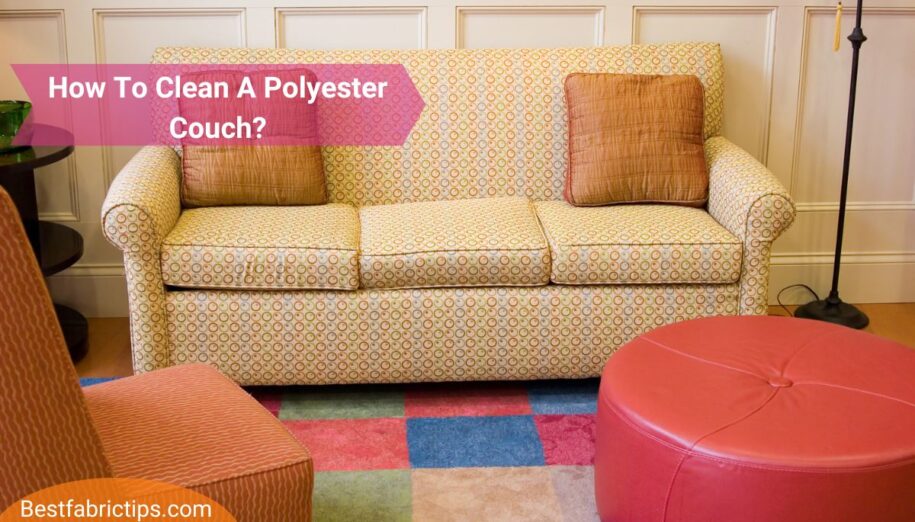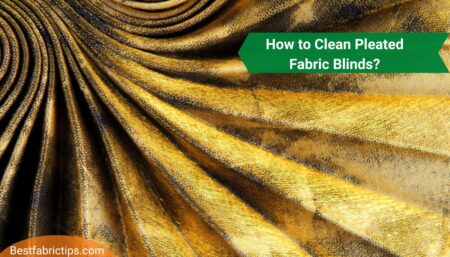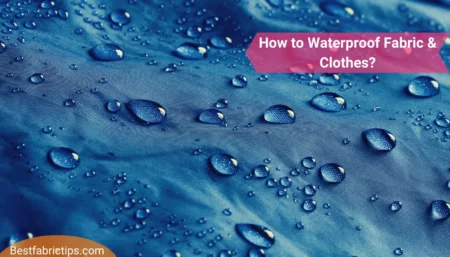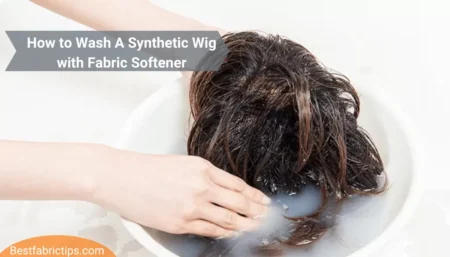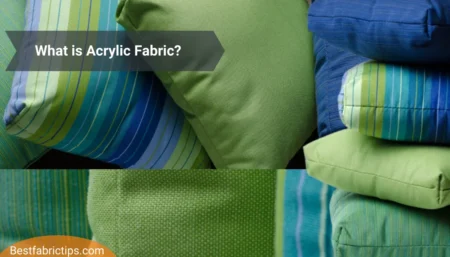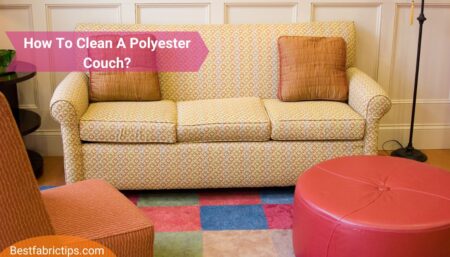Is Polyester Couch Hard To Clean?
Polyester couches can be relatively easy to clean, especially if they are made of a high-quality, tightly woven fabric. But, for better results, you should follow the manufacturer’s care instructions for the specific couch you have, as different types of polyester may have different cleaning requirements. If you are wondering how to clean a polyester couch, then here are a few general cleaning tips.
- Using a lint roller or a soft brush, remove any loose dirt or debris from the couch’s surface.
- Make a solution of a mild detergent and Luke warm water and dip a sponge or clean cloth into the solution and gently scrub the surface of the couch.
- Rinse the couch with clean water and a damp cloth, then blot dry with a clean towel.
- If the couch is heavily soiled or stained, you may need to use a specialized upholstery cleaner. Follow the cleaner’s instructions carefully, and test it on a small, inconspicuous area of the couch before using it on the entire surface.
- Air dry the couch complete before using it. Avoid sitting on the couch while it is still wet, as this can cause the fabric to stretch or become misshapen.
Always apply gentle touch and avoid harsh scrubbing or using strong chemicals on your polyester couch, as this can cause the fabric to become damaged or discolored.
Can I steam clean a polyester couch?
Yes, steam cleaning a polyester couch is generally safe. Steam cleaning upholstery can be an effective way to remove stains and kill bacteria and other germs. When steam cleaning a polyester couch, it is important to use caution because the heat and moisture from the steam can cause the fabric to become stretched or distorted if not used properly.
Here are some steam cleaning tips for a polyester couch:
- To ensure that the steam cleaner does not damage the fabric, test it on a small, inconspicuous area of the couch.
- To avoid damaging the fabric, use a low heat setting on the steam cleaner.
- To avoid oversaturating the fabric, keep the steam cleaner at least 6 inches away from the couch.
- When steam cleaning the couch, use a gentle, circular motion to avoid damaging the fabric.
- After steam cleaning, let the couch air dry completely. Avoid sitting on the wet couch, as this can cause the fabric to stretch or become misshapen.
Always follow the manufacturer’s instructions for your specific steam cleaner, and proceed with caution when steam cleaning any type of upholstery. If you are unsure how to properly steam clean your couch, you should consult a professional upholstery cleaner.
How to clean polyester couch without water?
There are several ways to clean a polyester sofa without water:
- Utilize a dry cleaning agent: Polyester stains can be effectively removed by dry cleaning chemicals, which are designed to clean materials without water. Before applying the solvent to the entire surface of the couch, make sure to follow the label’s directions and test it on a tiny, inconspicuous spot.
- Fabric cleaners are precisely created to eliminate stains and grime from upholstery without water. Simply spray the cleaner onto the afflicted area and remove the stain with a clean towel by blotting.
- Combine baking soda and white vinegar: Mix baking soda and vinegar to form a paste, then apply the mixture to the stain with a clean cloth. Use a dry cloth to remove the paste once it has rested for a few hours.
- A vacuum cleaner can be an excellent instrument for eliminating dirt and debris from a polyester sofa. Utilize the upholstery attachment for suction dirt and crumbs from the couch’s surface.
Before applying a cleaning solution or method to the entire couch, it is essential to test it on a tiny, inconspicuous area to guarantee that it will not cause damage.
How do you spot clean polyester upholstery?
Follow these procedures to spot clean polyester upholstery:
- Using a spoon or butter knife, clear the impacted area of any solid debris.
- Blot the stain to moisten it with a clean, white cloth that has been lightly dampened with water.
- In a bowl or spray bottle, combine a little amount of mild detergent with water.
- Using a clean cloth or a sponge, dab the stain with the cleaning solution.
- To get rid of the stain and the cleaning solution, blot it with a fresh, white cloth.
- Until the stain is entirely gone, repeat steps 3-5.
- To get rid of any leftover cleaning solution, rinse the area with a fresh, moist cloth.
- To remove any extra wetness, blot the region with a clean, dry cloth.
- Before utilizing the couch once more, let the affected area thoroughly dry by air.
When spot-cleaning polyester upholstery, it’s crucial to be gentle because scrubbing or rubbing too vigorously might harm the fabric. Before using any cleaning product or technique over the full surface of the couch, it is advisable to try it on a tiny, discrete area first to be sure it won’t harm the fabric.
Can you clean 100% polyester?
Polyester is durable and stain-resistant, yet it can still get dirty. 100% polyester cleaning tips are following:
- Care label: Polyester clothing and upholstery have care labels with cleaning instructions. Use this guide to clean properly.
- Use a gentle detergent: Polyester, a synthetic fabric, fades easily. Harsh detergents and bleaches can discolor cloth.
- Polyester shrinks and fades with heat, so wash it in cold water.
- Polyester is susceptible to high heat, so don’t over-dry it in the dryer. Set the dryer to low or medium heat and remove the item when it’s dry.
- Avoid ironing: High heat might distort or shine polyester. Use low heat and a towel to iron polyester.
- Dry clean: If the care label recommends dry cleaning, take it to a licenced dry cleaner.
Following these steps should clean 100% polyester cloth.
How do you clean a 100% polyester microfiber couch?
To clean a 100% polyester microfiber couch, follow these steps:
- Using a spoon or a butter knife, remove any solid debris from the couch.
- Remove any loose dirt or crumbs from the couch by vacuuming it. Use the upholstery attachment to gently suction dirt and debris from the couch’s surface.
- In a bowl or spray bottle, combine a small amount of mild detergent and warm water.
- To ensure that the cleaning solution does not cause any damage, test it on a small, inconspicuous area of the couch.
- Using a clean, damp cloth or sponge, apply the cleaning solution to the affected area.
- To remove the cleaning solution and the stain, gently blot the stain with a clean, white cloth.
- Remove any remaining cleaning solution by rinsing the area with a clean, damp cloth.
- To remove any excess moisture, blot the area with a clean, dry cloth.
- Allow the couch to completely dry before reusing it.
When cleaning a 100% polyester microfiber couch, it’s important to be gentle because scrubbing or rubbing too hard can damage the fabric. Avoid using harsh detergents or bleaches, as these can discolor the fabric. If the stain is especially stubborn, you may need to repeat these steps several times to completely remove it.
What is the cleaning code for a polyester couch?
The cleaning code for a polyester couch (also known as the fabric care code) is often a letter or a combination of characters indicating the proper cleaning procedures for the sofa. These are the most frequent cleaning codes for polyester upholstery:
- W: This code indicates that water-based cleaning products or foam may be used to clean the sofa. You can spot-clean the sofa with a little detergent and warm water, or you can use a fabric cleaner developed specifically for upholstery.
- S: This code indicates that a dry cleaning solvent should be used to clean the sofa. Before applying the solvent to the entire surface of the couch, make sure to follow the recommendations on the package and test it on a tiny, inconspicuous spot.
- SW: This code indicates that either water-based cleaning chemicals or dry cleaning solvents may be used to clean the sofa.
- X: This code specifies that the sofa should only be vacuumed or brushed. Avoid using cleaning products and water while cleaning a sofa according to this guideline.
It is essential to always follow the couch’s cleaning code to guarantee that you are using the correct cleaning procedures and to prevent fabric damage. The cleaning code is typically located on the care label or a tag or sticker that is connected to the sofa. If the cleaning code cannot be located or is not provided, it is prudent to err on the side of caution and use a dry cleaning solvent or an upholstery-specific fabric cleaner.
Can you shampoo a polyester couch?
Most of the time, shampooing a polyester couch is not a good idea because the high water and detergent content of a shampoo solution can cause the fabric to become too wet and shrink or change color. Also, the heat and friction created by shampooing can change the shape of the fabric or damage it.
Instead of shampooing, you can clean any stains or dirt on a polyester couch with a mild detergent and warm water. You can also use a fabric cleaner made especially for upholstery. Follow the directions on the cleaning product’s label and test it on a small, hidden part of the couch before using it on the whole thing.
If the couch is very dirty, you may need to have it cleaned by a professional. A lot of dry cleaners offer upholstery cleaning services. To clean and refresh the fabric, they use special tools and chemicals.
Is vinegar safe on polyester?
Vinegar can be used on polyester fabric, but exercise caution. Use vinegar moderately and dilute it with water because polyester fades easily and is susceptible to acidic substances.
Use vinegar on polyester only to spot-treat stains. Apply the vinegar-water solution to the discoloration using a clean cloth. To remove cleaning solution and stain, blot with a clean white cloth. Rinse the area with a clean, damp cloth to remove any cleaning solution, then blot it dry.
To make sure the vinegar solution doesn’t damage the cloth, examine a small, inconspicuous spot first. Avoid vinegar if it discolors or fades cloth.
Does polyester get ruined in the wash?
Polyester resists shrinking and fading, but improper washing can harm it. Follow these washing guidelines to protect polyester:
- Care label: Polyester clothing and upholstery have care labels with washing instructions. Use this guide to wash properly.
- Use a gentle detergent: Polyester, a synthetic fabric, fades easily. Harsh detergents and bleaches can discolor cloth.
- Cold wash: Polyester shrinks and fades easily, so wash it in cool water.
- Polyester is susceptible to high heat, so don’t over-dry it in the dryer. Set the dryer to low or medium heat and remove the item when it’s dry.
- Ironing: Avoid ironing polyester, which might become glossy or distorted. Use low heat and a towel to iron polyester.
These tips can help protect polyester from washing.
How to clean urine from polyester couch?
You can use the following procedures to remove urine from a polyester couch:
- Using a spoon or butter knife, clear the impacted area of any solid debris.
- Blot the stain to moisten it with a clean, white cloth that has been lightly dampened with water.
- In a bowl or spray bottle, combine a little amount of mild detergent with water.
- Using a clean cloth or a sponge, dab the stain with the cleaning solution.
- To get rid of the stain and the cleaning solution, blot it with a fresh, white cloth.
- To get rid of any leftover cleaning solution, rinse the area with a fresh, moist cloth.
- To get rid of any extra wetness, blot the region with a clean, dry cloth.
- Before utilizing the couch once more, let the affected area thoroughly dry by air.
- If the pee stain is very difficult to remove, you might have to repeat these procedures multiple times.
After making repeated tries to remove the stain, you might need to use a specialized enzyme-based cleaner made especially for removing pee stains. Before using the cleaner on the entire stain, make careful to test it on a tiny, inconspicuous section of the couch according to the manufacturer’s directions.

